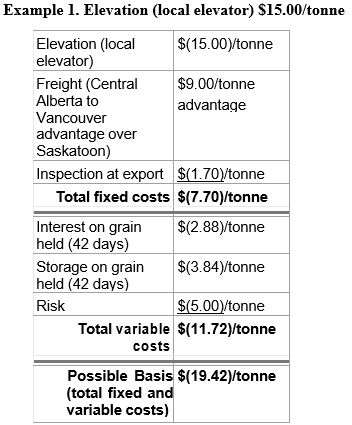| | Introduction
Basis is the difference between a local cash (or street) price and the futures market price for that commodity. Basis is calculated as “Cash Price” minus “Futures Price”. Basis for storable products like grain is influenced by (1) the cost of getting grain from a local delivery point to the point of use (or delivery locations of the related futures market), and (2) by the local supply-demand situation.
A farm manager can make better choices about when to market, where to market, and how to lock in prices by following basis levels.
How Basis Works
Grain buyers use basis to attract grain when they require it. Buyers who offer a higher local cash price are actually offering a stronger basis than their competitors. The higher cash price encourages delivery to that company versus its competitors. Elevator tariffs, interest costs, expected storage time, and the buyer’s perception of possible changes in risk and opportunity all can affect the cash price offered by a grain company.
Example 1 shows the factors that can be in a Central Alberta canola basis. The example is based on a cash canola price of $500 per tonne, 5 per cent prime interest rate and storage of $0.12 per tonne per day beginning after the first 10 days. The ICE Canada canola futures market prices canola seed free-on-board trucks or rail cars in the par delivery region in Saskatchewan. Because the futures price is FOB truck or rail car and not in-store elevator, elevation is not technically part of canola basis. However, grain companies will include a cost for elevation (as well as other costs and profit) to the extent that competition and willing producer selling will allow.

In Example 1 above, the company canola buyer has calculated that a reasonable basis for the company to offer for today’s delivery at one of its Central Alberta facilities would be $20 per tonne under the nearby November futures. Grain companies may offer a stronger basis to attract near-term deliveries for a sale with a tight shipping window, or competition from another buyer may cause them to bid more aggressively for their canola needs. For example, the company’s canola buyer decides to offer a basis of $10 per tonne under the November futures to try to draw in more supplies over a certain time period. Canola basis levels can also be positive, resulting in an “over” basis where the cash price is higher than the reference futures price.
Keep an Eye on the Basis
A strong basis signals a high local cash price relative to the futures market, and usually means stronger local demand or limited local supplies. A weakening basis means weakening local demand or very large local supplies compared to the over-all supply-demand picture for that commodity. Strengthening and weakening can occur gradually or quickly.
Southern Alberta basis ranges for canola are occasionally as strong as $10.00 or stronger over
(futures) with weak basis levels $40 under (futures) or weaker.
As a futures month that is used as the reference for a grain buyer’s cash price nears its’ maturity period, grain buyers will “roll” their reference futures month to the next futures month. Grain companies do not make their futures roll on the same day as each other. At the time of this roll, the price spread between the two futures months can result in a change in basis level for each company and a change in comparative basis levels between companies.
Basis Strategies
Basis is an important tool for producers in following a market and choosing what buyer to contract with. The first step in making this decision is to compare the basis currently offered at the expected time of delivery to the typical basis at the time of delivery. This comparison, together with an assessment of supply and demand factors, will help to predict whether the basis will weaken or strengthen between now and the time the grain will be delivered.
A weak basis suggests that a producer would be better off to consider using an open-basis contract, that is, to hedge using futures and wait for basis to improve. A strong basis, one that is more subject to weakening by delivery time, suggests using a deferred delivery contract or a basis contract to lock in that strong basis. Understanding how exchange rates factor into the calculation of basis is explained in the “Wheat Basis Levels” article of the Agricultural Marketing Guide.
Summary
The futures market provides both forward pricing and hedging opportunities for both producers and buyers. Street, or cash prices, reflect the futures price less (or plus) the basis. Basis is adjusted by buyers to encourage or discourage delivery of grain.
Basis is a signal of market forces at work and will change over time as the cash market price and futures market prices change. Basis reflects both the cost of marketing grain as well as the competition between grain buyers, and does not change as often as do futures prices.
Farmers should watch both basis trends as well as cash and futures market price trends to select the time to price their grain. Refusing to sell grain because basis is $5.00 per tonne too weak could mean a lower cash price at a later date due to a much larger than $5.00 per tonne drop in futures prices.
Additional Information
See “Using Hedging to Protect Farm Product Prices” in the Market Risk Management Section for an explanation of hedging using the futures market. |
|